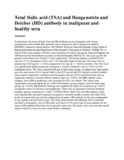| dc.contributor.author | Kanduma, E G | |
| dc.contributor.author | Mukuria, J C | |
| dc.contributor.author | Mwanda, O W | |
| dc.date.accessioned | 2013-04-22T13:47:45Z | |
| dc.date.available | 2013-04-22T13:47:45Z | |
| dc.date.issued | 2007-05 | |
| dc.identifier.citation | East Africa Medical Journal 2007 May, 84(5): 207-14 | en |
| dc.identifier.uri | http://www.ncbi.nlm.nih.gov/pubmed/17892194 | |
| dc.identifier.uri | http://erepository.uonbi.ac.ke:8080/xmlui/handle/123456789/16513 | |
| dc.description | Journal article | en |
| dc.description.abstract | OBJECTIVE:
To determine the levels of both TSA and HD antibody in sera of patients with various malignancies and evaluate their potential role as diagnostic and/ or prognostic markers.
DESIGN:
Laboratory based analysis.
SETTINGS:
Kenyatta National Hospital, Kenya Medical Research Institute and the Department of Biochemistry, University of Nairobi.
SUBJECTS:
A total of 909 serum samples, 420 from cancer patients recruited at Kenyatta National Hospital and 509 from normal blood donors recruited at Nairobi Hospital.
RESULTS:
The mean age for the patients and controls was 36 and 37 years respectively. Carcinoma patients constituted 54%, sarcoma 12.1%, lymphoma 16.4% and 17.4% had other types of tumours. The mean TSA in patients was 0.86 mg/ml +/- 0.026 compared to 0.82 mg/ml +/- 0.014 in controls. The TSA level was significantly higher in patients compared to controls (Student's t-test p = 0.031 at 0.05 confidence level). The TSA increased with age in both study groups. In patient sera, both gender gave the same mean of 0.83 mg/ml while it was 0.82 mg/ml and 0.83 mg/ml in control females and in males respectively. Sarcomas had the highest amount of 0.93 mg/ml but there was no significant statistical variation between tumour types (p = 0.076). The HD antibody mean readings were 0.004 in pathologic sera compared to 0.011 in controls. The values were significantly elevated in patients (p = 0.03) with females giving a higher value for both study groups (p = 0.628). HD antibody readings was significantly higher in carcinomas (p = 0.017) compared to those of sarcomas and lymphomas. There was no association between antibody readings and age of patient (p = 0.601).
CONCLUSION:
Both TSA and HD antibody values were significantly elevated in patients compared to clinically healthy controls and while TSA levels increased with age and was independent of gender, HD antibody levels were independent of age, gender and also tumour type. The study demonstrates that although TSA is normally elevated in malignancy, most of the sialic acid shed is of N-acetyl type as some patients do not express HD antibody directed to the N-glycolyl sialic acid. The reason why some tumours would express Neu5Gc at any one time needs further evaluation. | en |
| dc.language.iso | en | en |
| dc.subject | Serum total sialic acid | en |
| dc.subject | Hanganutziu-Deicher antibody | en |
| dc.subject | Normals | en |
| dc.subject | Cancer patients | en |
| dc.title | Total Sialic acid (TSA) and Hanganutziu and Deicher (HD) antibody in malignant and healthy sera | en |
| dc.type | Article | en |
| local.publisher | College of Health Sciences, University of Nairobi | en |

